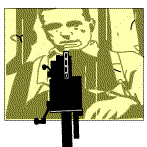Movies
Created | Updated May 23, 2008

The word 'movie' derives from the phrase 'motion picture'. A movie is a series of two-dimensional pictures rapidly projected onto a large white screen, giving the the illusion of three-dimensional movement. This is done using a form of photographic film called celluloid that is rapidly passed across a light projector, at a rate of scores of frames per second. Each frame is a separate cell on the long strip of film; and the number of frames, coupled with the speed at which they are run across the projected light, work together to create the illusion of motion in the resulting picture.
A commonly accepted definition of 'movie' is a visual/audio presentation that takes approximately 90 minutes to two hours to see, and shown in cinemas especially designed for such entertainment.
The History of Movies
In the 1880s, french physician EJ Marey made the first known motion pictures. Thomas Edison invented the Kinetoscope about a decade later, which increased interest in the concept, in part because of Edison's production of 'Peep Shows', in which women undressed and did arousing things in front of the camera. Smut has been a part of film for about as long as there has been film to put smut on. In 1905, the first 'nickelodeon', or early movie theatre, appeared in Pittsburg, Pennsylvania, USA.
Movies didn't start out as 'talkies'. Originally all movies were silent. They were usually a part of a programme of entertainment that included live music and comedy. A guy in the theatre would accompany the action on a piano or organ, such as the famously magestic Wurlitzer Organs. Filmmakers also broke up the action of the film with dialogue written out in white letters on black backgrounds. This was so viewers would actually know what was being said. Unfortunately, this meant that you needed to know how to read in order to know what was going on.
Movies were originally in black and white. Colour didn't come around until around the 1940s. The first talking film was Al Jolson's The Jazz Singer in 1927.
Buster Keaton and Charlie Chaplin were two of the first international celebrities, who became popular during the early part of the 20th Century. Their slapstick comedy still entertains people today. Most talent for early silent films came from stage shows known as Vaudeville, but when talking films came along, many silent film stars, such as Rudolph Valentino, were unable to make the transition.
In North America, drive-in movie theatres used to be really popular. You and your family could drive out to a glorified parking lot with a big silver screen and speakers that you could hang from your window. In the 1970s and '80s, drive-in movie theatres began to lose popularity. As land prices soared, many drive-in theatres became too expensive to operate, and many were turned into new suburbs.
In 1976, dolby stereo was introduced into cinemas, and then in 1985 television began being broadcast in stereo, so many movie theatres turned to THX stereo, made popular with the help of George Lucas' The Empire Strikes Back and other ground-breaking films.
Today, cinemas seem to be losing the battle against complex home entertainment systems with DVD players, cable, and high definition television. It's more comfortable for people to stay home and enjoy their favourite films, often less than a year after they come out on the silver screen. You always have a front seat, you can make your popcorn in a microwave oven, and you can pause the film if you need to take a quick trip to the kitchen to make a cup of tea. The movie industry seems to be running out of tricks.
What Are the Best Films of All Time?
The online Internet Movie Database has an ongoing vote tabulation for the Top 250 Movies of all time. It's a popular vote that fluctuates over time, but gives a good idea of what many people consider to be the best films.
The US government created the National Film Preservation Board in 1988 in order to preserve certain films. Since 1989 this board selects 25 films it feels have withstood the test of time. This list of films is known as the National Film Registry, and includes a wide selection of some of the best films ever made. However, the argument over which films are the best depends upon each individual's tastes. One man's Bonnie and Clyde is another's Harold and Maude.
It's all a matter of taste. Subjectivity is king, which makes the film industry very volatile and unpredictable. Those with the money to invest in filmmaking are gamblers, and what they gamble on is whether or not their movies will interest you enough to go and see them.

